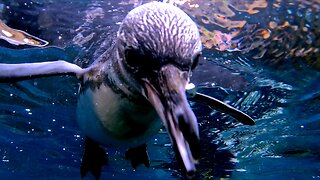Premium Only Content

Anemone fish can live where few other fish can
Sea anemones are predatory animals that anchor to the coral and sway in the ocean current as they search for food. Their tentacles can resemble the long leaves of a plant as they grasp at fish and small animals that serve as food for the sea anemone. In some species, the tentacles are much shorter. The tentacles contain stinging cells that are equipped with an external sensory hair. When triggered, the cells fire a harpoon-like barb and inject a toxin. This can be used as defense or for hunting. Small fish and other marine animals become paralyzed and are then devoured by the sea anemone.
But there are fish that are immune to the sting of the sea anemone. Clown fish and anemone are well known exceptions, with their mucous that prevents the activation of the sea anemone's stingers. Clown fish are the best known, but not the only fish with the ability to produce this mucous. There are a few other species that are referred to as anemone fish. These two are the Fiji anemone fish. They live among the deadly anemones, taking cover at the slightest sign of a threat. Predators don't dare follow the anemone fish into the tentacles and the small fish are safe within.
These fish continuously rub up against the tentacles, even when predators are not near. The contact with the anemone helps them accumulate mucous which combines with their own mucous to produce the substance that masks their presence from the stinging cells.
The anemone benefits from the fish in a perfect example of a symbiotic relationship. The anemone fish becomes aggressive and chases other fish away that might nibble at the tentacles of the anemone. The fish excrement provides the anemone with nutrients. The entire arrangement is a win-win situation for both animals.
Anemone fish are loyal to an anemone, remaining in the same location and protecting their host. Often found in groups, there will be one breeding male and one breeding female. If the female dies, the male will turn into a female and the largest non-breeding male will assume the role of being the male breeder.
Anemone fish feed primarily on zooplankton that drift past on the ocean currents. As expected, these fish were found on the reef surrounding an island in the Republic of Fiji.
-
 1:40
1:40
WildCreatures
23 days ago $0.78 earnedCurious Penguins Approach Swimmers for a Close Inspection
3.23K2 -
 1:41:14
1:41:14
Megyn Kelly
13 hours agoMace's Quest to Protect Women's Spaces, and RFK vs. Media and Swamp, w/ Casey Means and Vinay Prasad
67.7K108 -
 5:08:25
5:08:25
Drew Hernandez
10 hours agoLAKEN RILEY'S KILLER CONVICTED & GIVEN LIFE IN PRISON
55.5K67 -
 59:31
59:31
Man in America
15 hours agoEven WW3 Can't Stop What's Coming—the Cabal is COLLAPSING w/ Todd Callender
102K72 -
 3:51:28
3:51:28
I_Came_With_Fire_Podcast
15 hours agoSPECIAL LIVE FIRE w/ Bearded Viking Mead Co
81.5K9 -
 1:28:52
1:28:52
Kim Iversen
13 hours agoUnmasking the Truth: Most Censored Historian On Past Election Meddling, COVID, and Trump
78.3K69 -
 2:10:00
2:10:00
TheSaltyCracker
11 hours agoNow Lefties Lose Bathroom War ReeEEeE Stream 11-20-24
148K362 -
 1:03:31
1:03:31
Fresh and Fit
13 hours agoWhy Men Need Options To Avoid Falling For This!
119K14 -
 1:26:56
1:26:56
Flyover Conservatives
1 day agoWar Raging, Bank Closing, and Humanoid Robots: It’s Biblical! - Clay Clark | FOC Show
55.8K14 -
 5:32:27
5:32:27
tacetmort3m
1 day ago🔴 LIVE - MY MOST ANTICIPATED GAME IS OUT - STALKER 2 LAUNCH DAY
29.1K